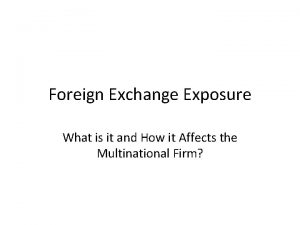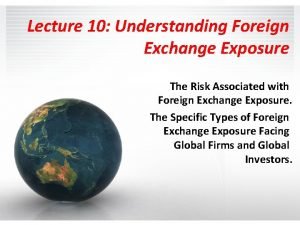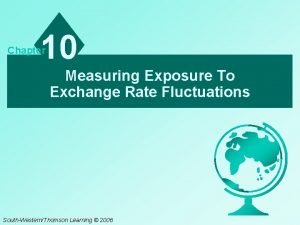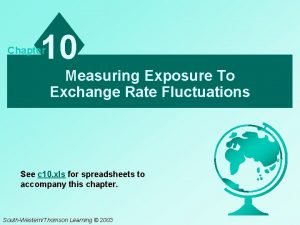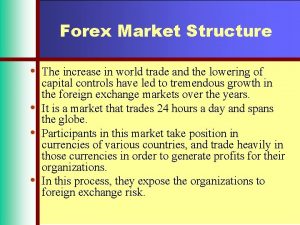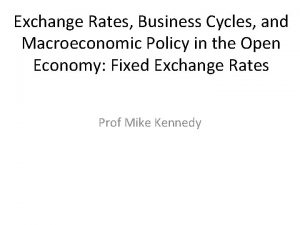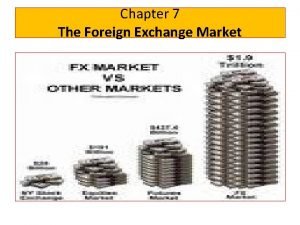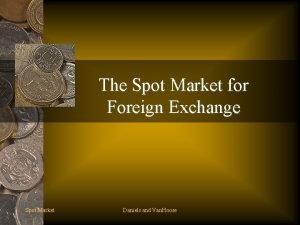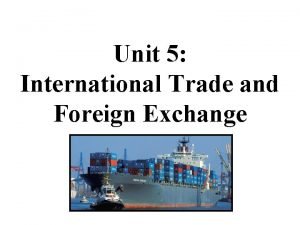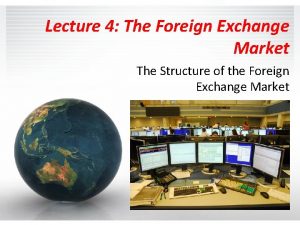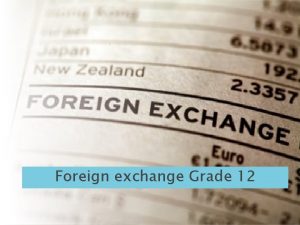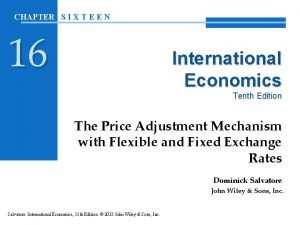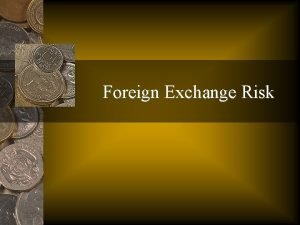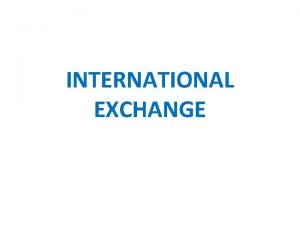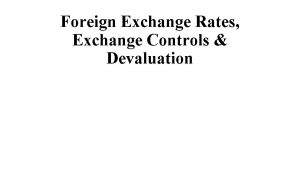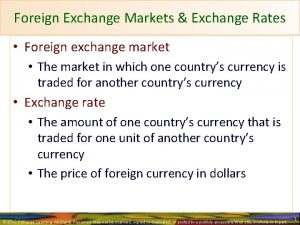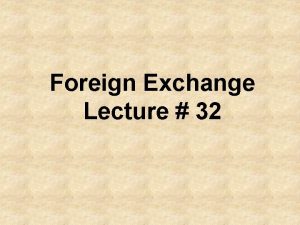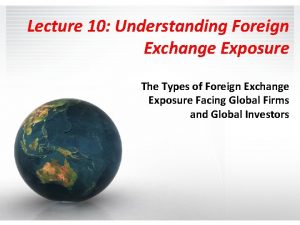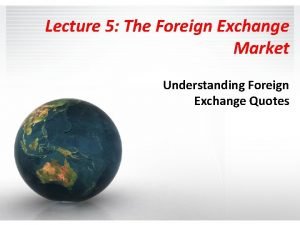Understanding Foreign Exchange Exposure In this lecture we


















- Slides: 18

Understanding Foreign Exchange Exposure In this lecture we will discuss the types of foreign exchange exposure facing global firms and global investors

What is Foreign Exchange Exposure and Exposure Risk? n Foreign exchange exposure comes about when a firm or investor has an open position in a foreign currency. q q n Open long position: Expects to receive foreign currency in the future Open short position: Needs to pay foreign currency in the future Foreign exchange exposure risk refers to the possibility that a foreign currency may move in a direction which is financially detrimental to the global firm or global investor. q Important: Global firms and investors cannot have foreign exchange exposure in their home currencies.

Risk with an Open Foreign Currency Position n Open long position (expect to receive foreign currency in the future). q n Specific risk is that the foreign currency may weaken against your home currency, thus reducing the home currency equivalent of the long position. Open short position (expect to pay foreign currency in the future). q Specific risk is that the foreign currency may strengthen against your home currency (thus requiring more home currency to acquire the foreign currency). This increases the home currency equivalent of the short position.

Global Companies and FX n Exposure What is the specific risk to a global firm from foreign exchange exposure? q (1) Settlement value of foreign currency denominated contracts, in the home currency equivalent of the firm, can be adversely affected. n n Open long position: At settlement (i. e. , when payment is received), the home currency equivalent is less than on origination date. Open short position: At settlement (i. e. , when payment is made), the home currency equivalent is more than on origination date.

Global Companies and FX Exposure -- Continued q (2) Cash flows from foreign operations, in home currency equivalents, can be adversely affected. n n q Cash inflows: Revenues denominated in foreign currencies will be worth less in home currency equivalents if the foreign currencies weaken. Cash inflows: Costs denominated in foreign currencies will be more in home currency equivalents if the foreign currencies strengthen. The net impact of the exposure, depends upon the net cash flow position of the firm. n n If revenues exceed costs, a strong foreign currency with have a net positive effect. If costs exceed revenues, a strong foreign currency will have a net negative effect.

Global Companies and FX Exposure -- Continued q (3) The global competitive position of the firm can be affected by adverse changes in exchange rates. n n n Exporting firms are adversely affected if the currencies of their overseas markets weaken. Importing firms are adversely affected if the currencies of their overseas markets strengthen. Overseas production is adversely affected if the currencies of these “outsourcing” countries strengthens.

Types of Foreign Exchange Exposure n There are three types of foreign exchange exposures that n global firms may face as a result of their international activities. These foreign exchange exposures are: q Transaction exposure n q Economic exposure n q Results for future and unknown transactions in foreign currencies resulting from a MNC long term involvement in a particular market (because of a long term physical presence in that foreign market). Translation exposure (sometimes called “accounting” exposure). n n Any MNC engaged in current transactions involving foreign currencies (e. g. , invoices coming due, loans coming due, interest payments coming due, etc). Important for MNCs with a physical presence in a foreign country and needing to consolidate financial statements for reporting purposes. We will develop each of these three exposures in the slides which follow.

Transaction Exposure n Transaction Exposure: Results from a firm taking on “fixed” cash flow foreign currency denominated contractual agreements. q Examples of transaction exposure: n n An Account Receivable denominate in a foreign currency. A maturing financial asset (e. g. , a bond) denominated in a foreign currency. An Account Payable denominate in a foreign currency. A maturing financial liability (e. g. , a loan) denominated in a foreign currency.

Transaction Exposure Resulting from Exporting and Importing Contracts Country Exports in Home Imports in Home Currency (% of invoices) United States 96. 0% 85. 0% Germany 81. 5% 52. 6% France 58. 5% 48. 9% United Kingdom 57. 0% 40. 0% Italy 38. 0% 27. 0% Japan 34. 3% 13. 3% Note: 1988 Data

Economic Exposure n Economic Exposure: Results from the “physical” entry of a global firm into a foreign country. q n n This is a long term foreign exchange exposure resulting from a previous FDI location decision. Economic exposure impacts the firm through contracts and transactions which have yet to occur, but will, in the future. These are really “future” transaction exposures which are unknown today. Economic exposure also impacts the firm through its operating income (revenue) and costs which are denominated in the currency of the foreign country.

Economic Exposure of U. S. Firms n Empirical studies of large U. S. multinational firms (with significant foreign operations) have generally found low or negligible foreign exchange exposure, i. e. , little variation in home currency equivalent revenues associated with exchange rate changes. q Explanation: U. S. multinational firms with significant revenues and costs in foreign currencies may have a natural offset (i. e. , balance) of revenues and costs. n n Referred to as “Operational Hedging. ” These studies also suggest that firms with large unbalanced revenue or cost streams are subject to substantial foreign exchange exposure. q See next slide

Change in USD Profit Levels for Unbalanced and Balanced Firm Assuming Different Euro/USD Exchange Rates $ 900 000 $ 800 000 USD Equivalent Profits $ 700 000 $ Profit Unbalanced Firm (Revenues € 900, 000; Costs € 500, 000) $ 600 000 $ 500 000 $ 400 000 $ Profit Balanced Firm (Revenues € 900, 000; Costs € 850, 000) $ 300 000 $ 200 000 $ 100 000 $- 1, 25 1, 35 1, 45 1, 55 1, 65 1, 75 1, 85 1, 95 2 2, 05 2, 1

Translation Exposure n Translation Exposure: Results from the need of a global firm to consolidated its financial statements to include results from foreign operations. q q Consolidation involves “translating” subsidiary financial statements in local currencies (i. e. , in the foreign markets where the firm is located) to the home currency of the firm (i. e. , the parent). Consolidation can result in either translation gains or translation losses. n These are essentially the accounting system’s attempt to measure foreign exchange “ex post” exposure.

Foreign Exchange Exposure for a Global Investor n Foreign exchange exposure for a global investor is fairly straight forward: q q Exposure results from the acquisition of financial assets denominated in a currency other than the home currency of the investor. Exposure can affect: n n (1) The market price of those assets and (2) The cash flows (dividends and interest) associated with particular financial assets.

Does Foreign Exchange Exposure Matter to Global Investors in Equities? n The risk elements associated with common stock (equities): q Company risk (micro risk): n q Environment risk (macro risk): n q Risk produced by the industry, country and global environment in which the company operates. Market risk (systematic risk): n q Decisions of management; success or failure of (new) products; competition Associated with movements in the overall equity market of a country. Exchange rate risk: n Associated with investing in equities who’s market price and dividends are denominated in other than the home country of the investor.

Exchange Rate Impacts on Equity Returns: Dec 31, 2009 – Country or Area L. C. Return USD Return Stock Index Nov 3, 2010 United States 7. 5% DJIA Japan -11. 5% +1. 2% Topix China -7. 6% -5. 5% SSEA Britain 6. 2% 5. 7% FTSE 100 Canada 7. 9% 12. 1% S&P TSX Germany 11. 1% 8. 5% DAX Switzerland -0. 5% 5. 0% SMI Australia -1. 8% 10. 0% All Ord. Mexico 11. 6% 18. 5% IPC Hong Kong 10. 4% Hang Seng

Does Foreign Exchange Exposure Matter to Global Investors in Bonds? n The risk elements associated with bonds (fixed income securities): q Default risk (credit risk): n q Market risk (price risk): n q Associated with changes in the market’s overall assessment of risk and willingness to take risk (or avert risk). Contagion risk: n q Decisions of management; success or failure of (new) products; competition Associated with spillover effects from other countries. Exchange rate risk: n Associated with investing in bonds who’s market price and interest payments are denominated in other than the home country of the investor.

Exchange Rates and Bond Yields n The gap between the U. S. dollar un-hedged and hedged Global Treasuries shows the effect currency has played in the annual returns. In most years, with the exception of 2005 and the first quarter of 2009, currency moves benefited the U. S. investor (this is shown by the difference between the un-hedged and hedge indexes).
 Foreign exchange exposures
Foreign exchange exposures Foreign exchange exposure
Foreign exchange exposure Managing economic exposure and translation exposure
Managing economic exposure and translation exposure Eksposur translasi adalah
Eksposur translasi adalah What is economic exposure?
What is economic exposure? Managing economic exposure and translation exposure
Managing economic exposure and translation exposure So here you are too foreign for home
So here you are too foreign for home Measuring exposure to exchange rate fluctuations
Measuring exposure to exchange rate fluctuations Measuring exposure to exchange rate fluctuations
Measuring exposure to exchange rate fluctuations Foreign exchange market structure
Foreign exchange market structure Exchange rate graph economics
Exchange rate graph economics Wise exchange program
Wise exchange program Kinds of foreign exchange market
Kinds of foreign exchange market Spot market in foreign exchange market
Spot market in foreign exchange market Difference between balance of trade and balance of payment
Difference between balance of trade and balance of payment Foreign exchange market
Foreign exchange market Structure of foreign exchange market
Structure of foreign exchange market Tourism grade 12 foreign exchange
Tourism grade 12 foreign exchange Stability of foreign exchange market
Stability of foreign exchange market
